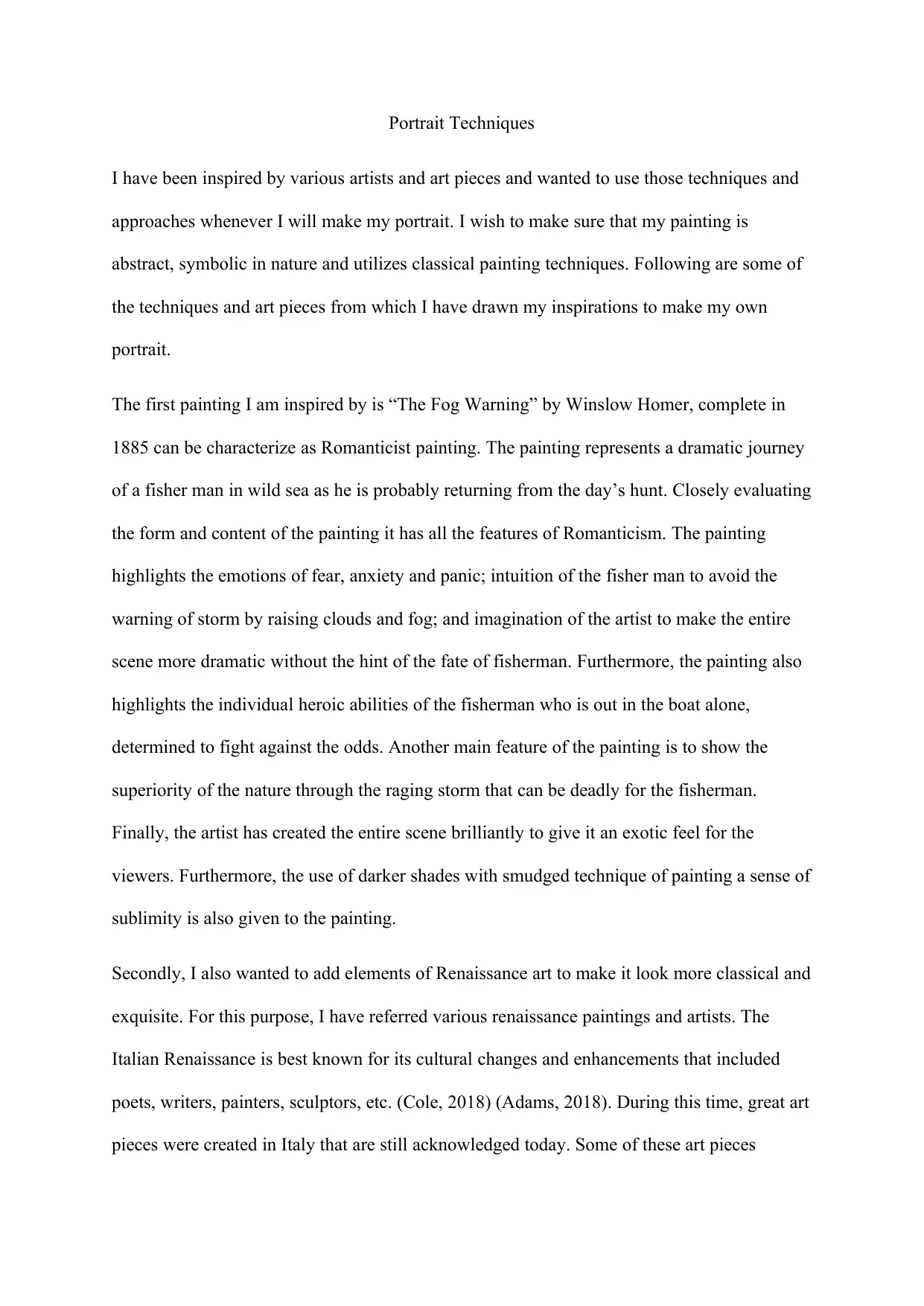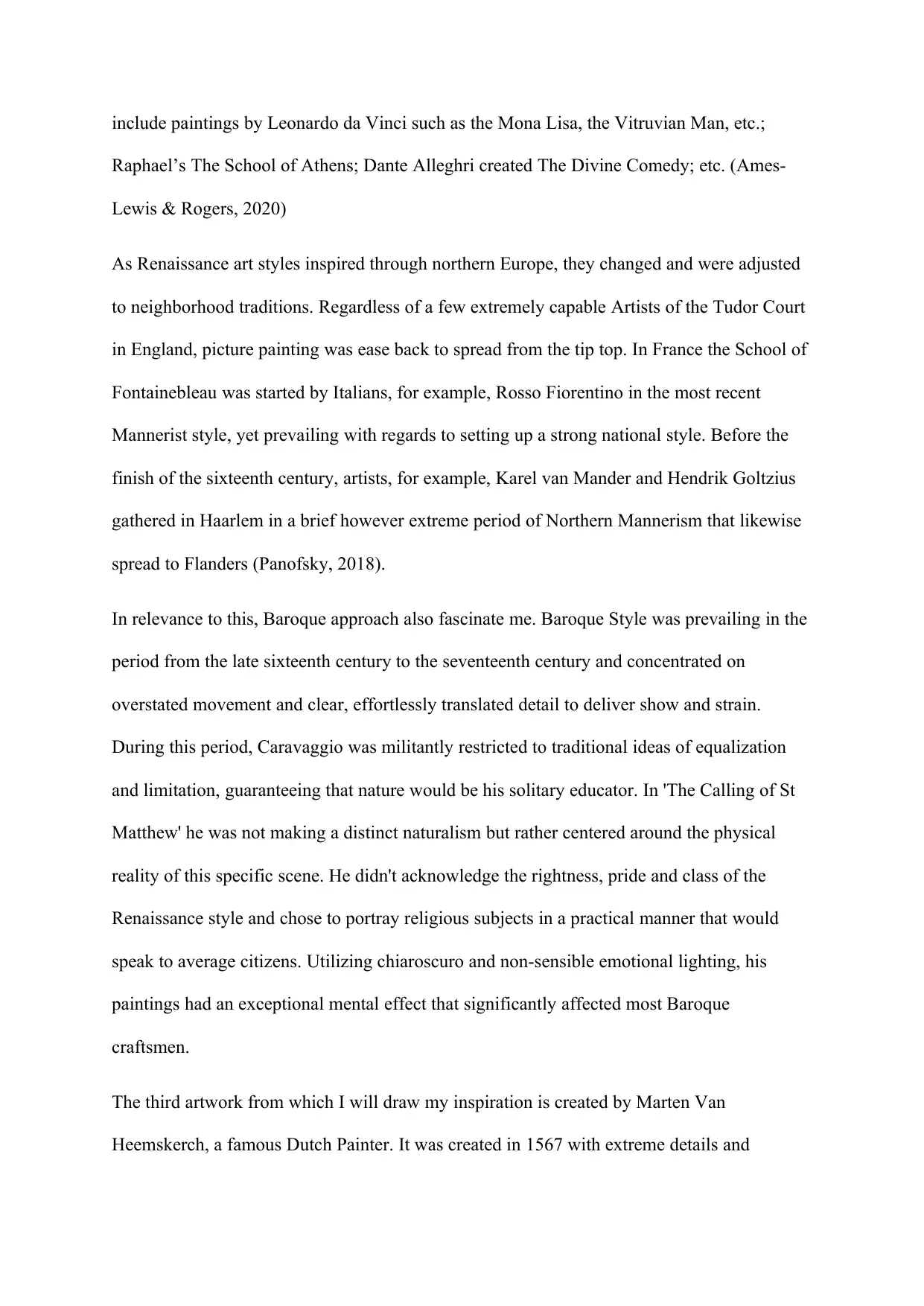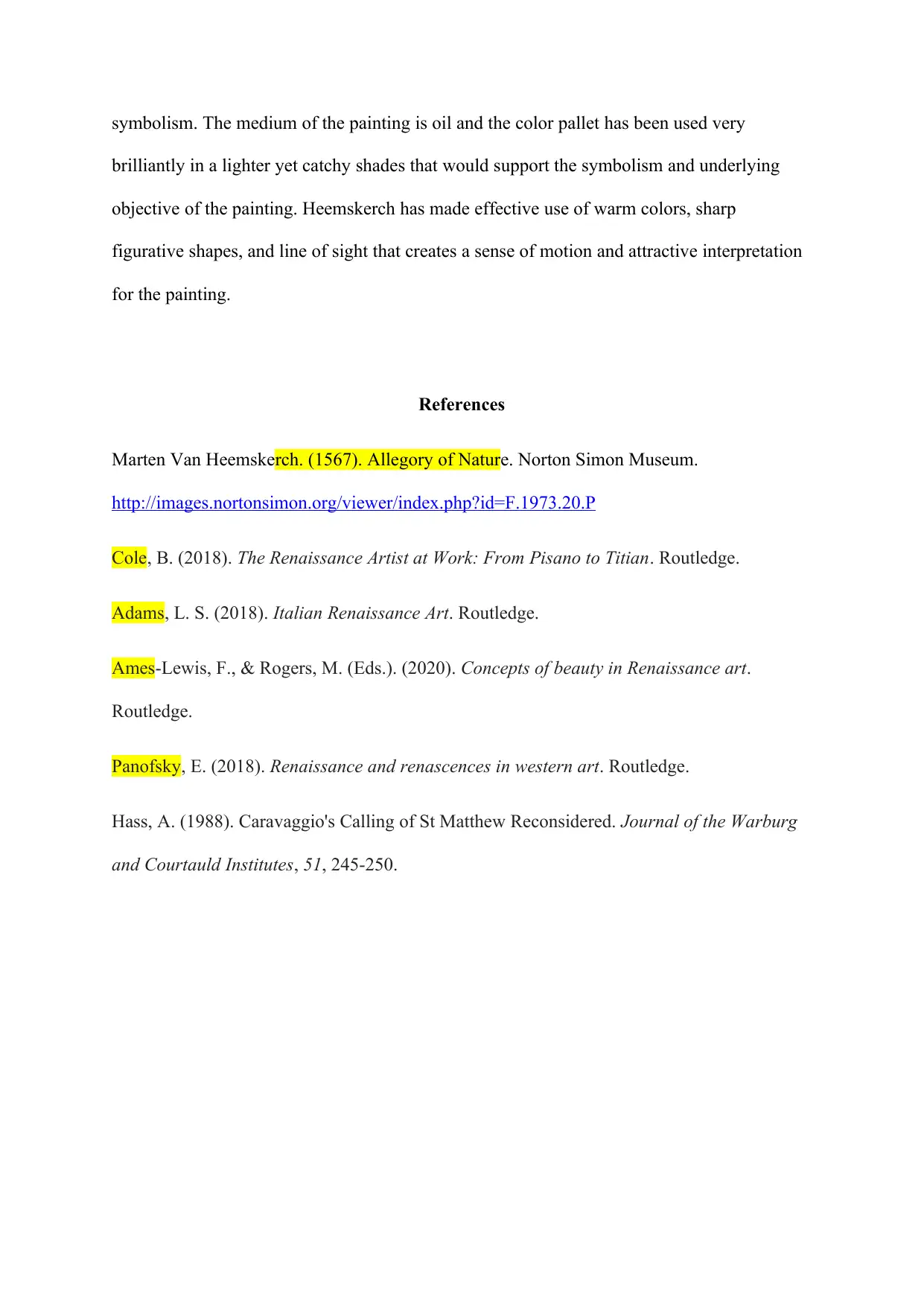Visual Arts: Portrait Techniques Inspired by Renaissance and Baroque
VerifiedAdded on 2023/03/30
|3
|768
|447
Practical Assignment
AI Summary
This assignment focuses on portrait techniques, drawing inspiration from various artists and art movements. The student explores techniques and approaches, aiming for an abstract and symbolic painting utilizing classical methods. The assignment analyzes artworks such as Winslow Homer's "The Fog Warning," highlighting Romanticist elements, and references Renaissance art, including works by Leonardo da Vinci and Raphael, and the Baroque style, particularly Caravaggio's influence. Additionally, the student draws inspiration from Marten Van Heemskerch's painting, "Allegory of Nature," analyzing its use of color and symbolism. The assignment aims to integrate these influences to create a unique portrait.

Portrait Techniques
I have been inspired by various artists and art pieces and wanted to use those techniques and
approaches whenever I will make my portrait. I wish to make sure that my painting is
abstract, symbolic in nature and utilizes classical painting techniques. Following are some of
the techniques and art pieces from which I have drawn my inspirations to make my own
portrait.
The first painting I am inspired by is “The Fog Warning” by Winslow Homer, complete in
1885 can be characterize as Romanticist painting. The painting represents a dramatic journey
of a fisher man in wild sea as he is probably returning from the day’s hunt. Closely evaluating
the form and content of the painting it has all the features of Romanticism. The painting
highlights the emotions of fear, anxiety and panic; intuition of the fisher man to avoid the
warning of storm by raising clouds and fog; and imagination of the artist to make the entire
scene more dramatic without the hint of the fate of fisherman. Furthermore, the painting also
highlights the individual heroic abilities of the fisherman who is out in the boat alone,
determined to fight against the odds. Another main feature of the painting is to show the
superiority of the nature through the raging storm that can be deadly for the fisherman.
Finally, the artist has created the entire scene brilliantly to give it an exotic feel for the
viewers. Furthermore, the use of darker shades with smudged technique of painting a sense of
sublimity is also given to the painting.
Secondly, I also wanted to add elements of Renaissance art to make it look more classical and
exquisite. For this purpose, I have referred various renaissance paintings and artists. The
Italian Renaissance is best known for its cultural changes and enhancements that included
poets, writers, painters, sculptors, etc. (Cole, 2018) (Adams, 2018). During this time, great art
pieces were created in Italy that are still acknowledged today. Some of these art pieces
I have been inspired by various artists and art pieces and wanted to use those techniques and
approaches whenever I will make my portrait. I wish to make sure that my painting is
abstract, symbolic in nature and utilizes classical painting techniques. Following are some of
the techniques and art pieces from which I have drawn my inspirations to make my own
portrait.
The first painting I am inspired by is “The Fog Warning” by Winslow Homer, complete in
1885 can be characterize as Romanticist painting. The painting represents a dramatic journey
of a fisher man in wild sea as he is probably returning from the day’s hunt. Closely evaluating
the form and content of the painting it has all the features of Romanticism. The painting
highlights the emotions of fear, anxiety and panic; intuition of the fisher man to avoid the
warning of storm by raising clouds and fog; and imagination of the artist to make the entire
scene more dramatic without the hint of the fate of fisherman. Furthermore, the painting also
highlights the individual heroic abilities of the fisherman who is out in the boat alone,
determined to fight against the odds. Another main feature of the painting is to show the
superiority of the nature through the raging storm that can be deadly for the fisherman.
Finally, the artist has created the entire scene brilliantly to give it an exotic feel for the
viewers. Furthermore, the use of darker shades with smudged technique of painting a sense of
sublimity is also given to the painting.
Secondly, I also wanted to add elements of Renaissance art to make it look more classical and
exquisite. For this purpose, I have referred various renaissance paintings and artists. The
Italian Renaissance is best known for its cultural changes and enhancements that included
poets, writers, painters, sculptors, etc. (Cole, 2018) (Adams, 2018). During this time, great art
pieces were created in Italy that are still acknowledged today. Some of these art pieces
Paraphrase This Document
Need a fresh take? Get an instant paraphrase of this document with our AI Paraphraser

include paintings by Leonardo da Vinci such as the Mona Lisa, the Vitruvian Man, etc.;
Raphael’s The School of Athens; Dante Alleghri created The Divine Comedy; etc. (Ames-
Lewis & Rogers, 2020)
As Renaissance art styles inspired through northern Europe, they changed and were adjusted
to neighborhood traditions. Regardless of a few extremely capable Artists of the Tudor Court
in England, picture painting was ease back to spread from the tip top. In France the School of
Fontainebleau was started by Italians, for example, Rosso Fiorentino in the most recent
Mannerist style, yet prevailing with regards to setting up a strong national style. Before the
finish of the sixteenth century, artists, for example, Karel van Mander and Hendrik Goltzius
gathered in Haarlem in a brief however extreme period of Northern Mannerism that likewise
spread to Flanders (Panofsky, 2018).
In relevance to this, Baroque approach also fascinate me. Baroque Style was prevailing in the
period from the late sixteenth century to the seventeenth century and concentrated on
overstated movement and clear, effortlessly translated detail to deliver show and strain.
During this period, Caravaggio was militantly restricted to traditional ideas of equalization
and limitation, guaranteeing that nature would be his solitary educator. In 'The Calling of St
Matthew' he was not making a distinct naturalism but rather centered around the physical
reality of this specific scene. He didn't acknowledge the rightness, pride and class of the
Renaissance style and chose to portray religious subjects in a practical manner that would
speak to average citizens. Utilizing chiaroscuro and non-sensible emotional lighting, his
paintings had an exceptional mental effect that significantly affected most Baroque
craftsmen.
The third artwork from which I will draw my inspiration is created by Marten Van
Heemskerch, a famous Dutch Painter. It was created in 1567 with extreme details and
Raphael’s The School of Athens; Dante Alleghri created The Divine Comedy; etc. (Ames-
Lewis & Rogers, 2020)
As Renaissance art styles inspired through northern Europe, they changed and were adjusted
to neighborhood traditions. Regardless of a few extremely capable Artists of the Tudor Court
in England, picture painting was ease back to spread from the tip top. In France the School of
Fontainebleau was started by Italians, for example, Rosso Fiorentino in the most recent
Mannerist style, yet prevailing with regards to setting up a strong national style. Before the
finish of the sixteenth century, artists, for example, Karel van Mander and Hendrik Goltzius
gathered in Haarlem in a brief however extreme period of Northern Mannerism that likewise
spread to Flanders (Panofsky, 2018).
In relevance to this, Baroque approach also fascinate me. Baroque Style was prevailing in the
period from the late sixteenth century to the seventeenth century and concentrated on
overstated movement and clear, effortlessly translated detail to deliver show and strain.
During this period, Caravaggio was militantly restricted to traditional ideas of equalization
and limitation, guaranteeing that nature would be his solitary educator. In 'The Calling of St
Matthew' he was not making a distinct naturalism but rather centered around the physical
reality of this specific scene. He didn't acknowledge the rightness, pride and class of the
Renaissance style and chose to portray religious subjects in a practical manner that would
speak to average citizens. Utilizing chiaroscuro and non-sensible emotional lighting, his
paintings had an exceptional mental effect that significantly affected most Baroque
craftsmen.
The third artwork from which I will draw my inspiration is created by Marten Van
Heemskerch, a famous Dutch Painter. It was created in 1567 with extreme details and

symbolism. The medium of the painting is oil and the color pallet has been used very
brilliantly in a lighter yet catchy shades that would support the symbolism and underlying
objective of the painting. Heemskerch has made effective use of warm colors, sharp
figurative shapes, and line of sight that creates a sense of motion and attractive interpretation
for the painting.
References
Marten Van Heemskerch. (1567). Allegory of Nature. Norton Simon Museum.
http://images.nortonsimon.org/viewer/index.php?id=F.1973.20.P
Cole, B. (2018). The Renaissance Artist at Work: From Pisano to Titian. Routledge.
Adams, L. S. (2018). Italian Renaissance Art. Routledge.
Ames-Lewis, F., & Rogers, M. (Eds.). (2020). Concepts of beauty in Renaissance art.
Routledge.
Panofsky, E. (2018). Renaissance and renascences in western art. Routledge.
Hass, A. (1988). Caravaggio's Calling of St Matthew Reconsidered. Journal of the Warburg
and Courtauld Institutes, 51, 245-250.
brilliantly in a lighter yet catchy shades that would support the symbolism and underlying
objective of the painting. Heemskerch has made effective use of warm colors, sharp
figurative shapes, and line of sight that creates a sense of motion and attractive interpretation
for the painting.
References
Marten Van Heemskerch. (1567). Allegory of Nature. Norton Simon Museum.
http://images.nortonsimon.org/viewer/index.php?id=F.1973.20.P
Cole, B. (2018). The Renaissance Artist at Work: From Pisano to Titian. Routledge.
Adams, L. S. (2018). Italian Renaissance Art. Routledge.
Ames-Lewis, F., & Rogers, M. (Eds.). (2020). Concepts of beauty in Renaissance art.
Routledge.
Panofsky, E. (2018). Renaissance and renascences in western art. Routledge.
Hass, A. (1988). Caravaggio's Calling of St Matthew Reconsidered. Journal of the Warburg
and Courtauld Institutes, 51, 245-250.
⊘ This is a preview!⊘
Do you want full access?
Subscribe today to unlock all pages.

Trusted by 1+ million students worldwide
1 out of 3
Your All-in-One AI-Powered Toolkit for Academic Success.
+13062052269
info@desklib.com
Available 24*7 on WhatsApp / Email
![[object Object]](/_next/static/media/star-bottom.7253800d.svg)
Unlock your academic potential
Copyright © 2020–2025 A2Z Services. All Rights Reserved. Developed and managed by ZUCOL.
